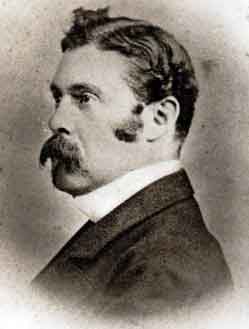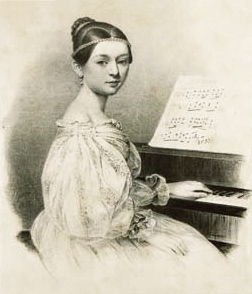Composition
The first edition in 1837 carried an annotation that the tune was "the composition of an amateur": this referred to the origin of the theme, which had been sent to Schumann by Baron von Fricken, guardian of Ernestine von Fricken, the Estrella of his Carnaval Op. 9. The baron, an amateur musician, had used the melody in a Theme with Variations for flute. Schumann had been engaged to Ernestine in 1834, only to break abruptly with her the year after. An autobiographical element is thus interwoven in the genesis of the Études symphoniques (as in that of many other works of Schumann's). [1]
Of the sixteen variations Schumann composed on Fricken's theme, only eleven were published by him. (An early version, completed between 1834 and January 1835, contained twelve movements). The final, twelfth, published étude was a variation on the theme from the Romance Du stolzes England freue dich (Proud England, rejoice!), from Heinrich Marschner's opera Der Templer und die Jüdin , which was based on Sir Walter Scott's Ivanhoe (as a tribute to Schumann's English friend, William Sterndale Bennett). The earlier Fricken theme occasionally appears briefly during this étude. The work was first published in 1837 as XII Études Symphoniques. Only nine of the twelve études were specifically designated as variations. The sequence was as follows:
- Theme – Andante [C♯ minor]
- Etude I (Variation 1) – Un poco più vivo [C♯ minor]
- Etude II (Variation 2) – Andante [C♯ minor]
- Etude III – Vivace [E Major]
- Etude IV (Variation 3) – Allegro marcato [C♯ minor]
- Etude V (Variation 4) – Scherzando [C♯ minor]
- Etude VI (Variation 5) – Agitato [C♯ minor]
- Etude VII (Variation 6) – Allegro molto [E Major]
- Etude VIII (Variation 7) – Sempre marcatissimo [C♯ minor]
- Etude IX – Presto possibile [C♯ minor]
- Etude X (Variation 8) – Allegro con energia [C♯ minor]
- Etude XI (Variation 9) – Andante espressivo [G♯ minor]
- Etude XII (Finale) – Allegro brillante (based on Marschner's theme) [D♭ Major]
Other titles had been considered in September 1834: Variations pathétiques and Etuden im Orchestercharakter von Florestan und Eusebius. In this latter case the Études would have been signed by two imaginary figures in whom Schumann personified two essential, opposite and complementary aspects of his own personality and his own poetic world. 'Florestan and Eusebius' then signed the Davidsbündlertänze , Op. 6; but only in the 1835 version of the Études symphoniques were the pieces divided so as to emphasize the alternation of more lyrical, melancholy and introvert pages (Eusebius) with those of a more excitable and dynamic nature (Florestan). In the 1837 version Florestan prevails.
Fifteen years later, in a second edition (Leipzig 1852), the 1837 title Études symphoniques became Études en forme de variations, two etudes (Nos. 3 and 9) that did not correspond to the new title (not being exactly variations) were eliminated, and some revisions were made in the piano writing.
The entire work was dedicated to Schumann's English friend, the pianist and composer William Sterndale Bennett. Bennett played the piece frequently in England to great acclaim, but Schumann thought it was unsuitable for public performance and advised his wife Clara not to play it.
Character
Leaving aside the allusions to Florestan and Eusebius, all of Schumann's proposed titles show some of the essential character of Op. 13's conception. This was of 'studies' in the sense that the term had assumed in Frédéric Chopin's Op. 10, that is to say, concert pieces in which the investigation of possibilities of technique and timbre in writing for the piano is carried out; they are 'symphonic études' through the wealth and complexity of the colours evoked – the keyboard becomes an "orchestra" capable of blending, contrasting or superimposing different timbres.
If etudes Nos. 3 and 9 are excluded, where the connection with the theme is tenuous, the etudes are in variation form. It was not the first time that Schumann had tackled variation form. [2] But here the variation principle is used more as free transformation, no longer of an actual theme, but of a musical 'cell' or cells (as for example in the same composer's Carnaval). The Études symphoniques learn the lesson of Beethoven's Diabelli Variations : the theme that acts as a unifying element is amplified and transformed, and becomes the basis from which blossom inventions of divergent expressive character. The work also shows the influence of the Goldberg Variations , most obviously in the use of a pseudo-French overture variation, and in the use of various canonic effects.
The highly virtuosic demands of the piano writing are frequently aimed not merely at effect but at clarification of the polyphonic complexity and at delving more deeply into keyboard experimentation. The Etudes are considered to be one of the most difficult works for piano by Schumann (together with his Fantasy in C and Toccata) and in Romantic literature as a whole. [3]
Later publication history
In 1861, five years after Schumann's death, his father-in-law Friedrich Wieck published a third edition under the editorial pseudonym "DAS" (an acronym for Der alte Schulmeister). This edition attempted to reconcile the differences between the earlier two, and bore both the previous titles XII Études Symphoniques and Études en forme de variations.
On republishing the set in 1890, Johannes Brahms restored the five variations that had been cut by Schumann. These are now often played, but in positions within the cycle that vary somewhat with each performance; there are now twelve variations and these five so-called "posthumous" variations which exist as a supplement.
The five posthumously published sections (all based on Fricken's theme) are:
- Variation I – Andante, Tempo del tema
- Variation II – Meno mosso
- Variation III – Allegro
- Variation IV – Allegretto
- Variation V – Moderato.

The Piano Concerto in A minor, Op. 54, by the German Romantic composer Robert Schumann was completed in 1845 and is the composer's only piano concerto. The complete work was premiered in Dresden on 4 December 1845. It is one of the most widely performed and recorded piano concertos from the Romantic period.

Carnaval, Op. 9, is a work by Robert Schumann for piano solo, written in 1834–1835 and subtitled Scènes mignonnes sur quatre notes. It consists of 21 short pieces representing masked revelers at Carnival, a festival before Lent. Schumann gives musical expression to himself, his friends and colleagues, and characters from improvised Italian comedy. He dedicated the work to the violinist Karol Lipiński.

Robert Schumann's Fantasiestücke, Op. 12, is a set of eight pieces for piano, written in 1837. The title was inspired by the 1814–15 collection of novellas, essays, treatises, letters, and writings about music, Fantasiestücke in Callots Manier by one of his favourite authors, E. T. A. Hoffmann. Schumann dedicated the pieces to Fräulein Anna Robena Laidlaw, an accomplished 18-year-old Scottish pianist with whom Schumann had become good friends.
The Grandes études de Paganini, S. 141, are a series of six études for the piano by Franz Liszt, revised in 1851 from an earlier version. It is almost exclusively in the final version that these pieces are played today.

Davidsbündlertänze, Op. 6, is a group of eighteen pieces for piano composed in 1837 by Robert Schumann, who named them after his music society Davidsbündler. The low opus number is misleading: the work was written after Carnaval, Op. 9, and the Symphonic Studies, Op. 13.
Legends, Op. 59, B. 117, is a forty-minute group of ten pieces by the Czech composer Antonín Dvořák. They were written in early 1881 for piano duet and reset later that year for a reduced orchestra (B. 122).

Marie-Alexis de Castillon de Saint-Victor was a French composer.
The Symphonic Variations, M. 46, is a work for piano and orchestra written in 1885 by César Franck. It has been described as "one of Franck's tightest and most finished works", "a superb blending of piano and orchestra", and "a flawless work and as near perfection as a human composer can hope to get in a work of this nature". It is a fine example of Franck's use of cyclic unity, with one theme growing into various others. The piano and orchestra share equally in the development of ideas. The work is in F♯ minor. Duration in performance is about fifteen minutes, and the instrumentation is piano solo and orchestra: pairs of flutes, oboes, clarinets, and bassoons; four horns; two trumpets; timpani; and strings.

Alexandre Levy was a Brazilian composer, pianist and conductor. Born in São Paulo, he pioneered a fusion of classical composition with Brazil's popular folk music and rhythms. Levy died prematurely at the age of 27, and is the first known musician to die at the infamous 27 Club age. His hometown grants a prestigious award in his name.

Christian Ludwig Schuncke was a German pianist and composer, and close friend of Robert Schumann. His early promise was eclipsed by his death from tuberculosis at the age of 23.

Frédéric Chopin's Variations on "Là ci darem la mano" for piano and orchestra, Op. 2, was written in 1827, when he was aged 17. "Là ci darem la mano" is a duet sung by Don Giovanni and Zerlina in act 1 of Mozart's 1787 opera Don Giovanni. In a manuscript of this composition, dedicated to his schoolfriend Tytus Woyciechowski, the latter replied on the title page in written form „J’accepte avec plaisir“. Chopin's work inspired Robert Schumann's famous exclamation: "Hats off, gentlemen, a genius." The work is often recorded and played in concert. A typical performance lasts from 17 to 19 minutes. One autograph of the version for solo piano is held by the Austrian National Library.

The Piano Sonata No. 1 in F♯ minor, Op. 11, was composed by Robert Schumann from 1833 to 1835. He published it anonymously as "Pianoforte Sonata, dedicated to Clara by Florestan and Eusebius".

The Piano Concerto in A minor, Op. 7, was composed by Clara Wieck, better known as Clara Schumann after her later marriage to Robert Schumann. She completed her only finished piano concerto in 1835, and played it first that year with the Leipzig Gewandhaus Orchestra, conducted by Felix Mendelssohn.
This page is based on this
Wikipedia article Text is available under the
CC BY-SA 4.0 license; additional terms may apply.
Images, videos and audio are available under their respective licenses.










